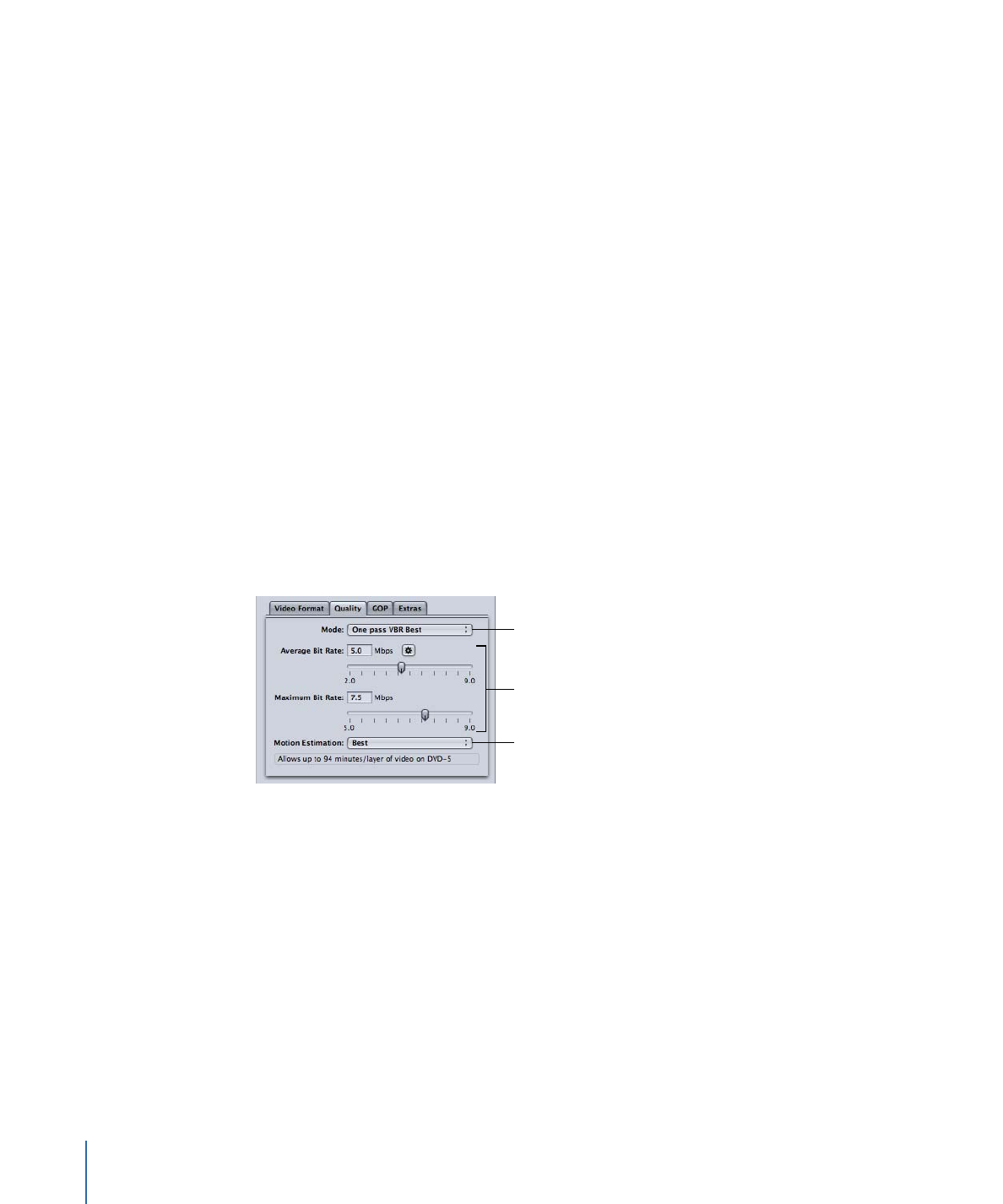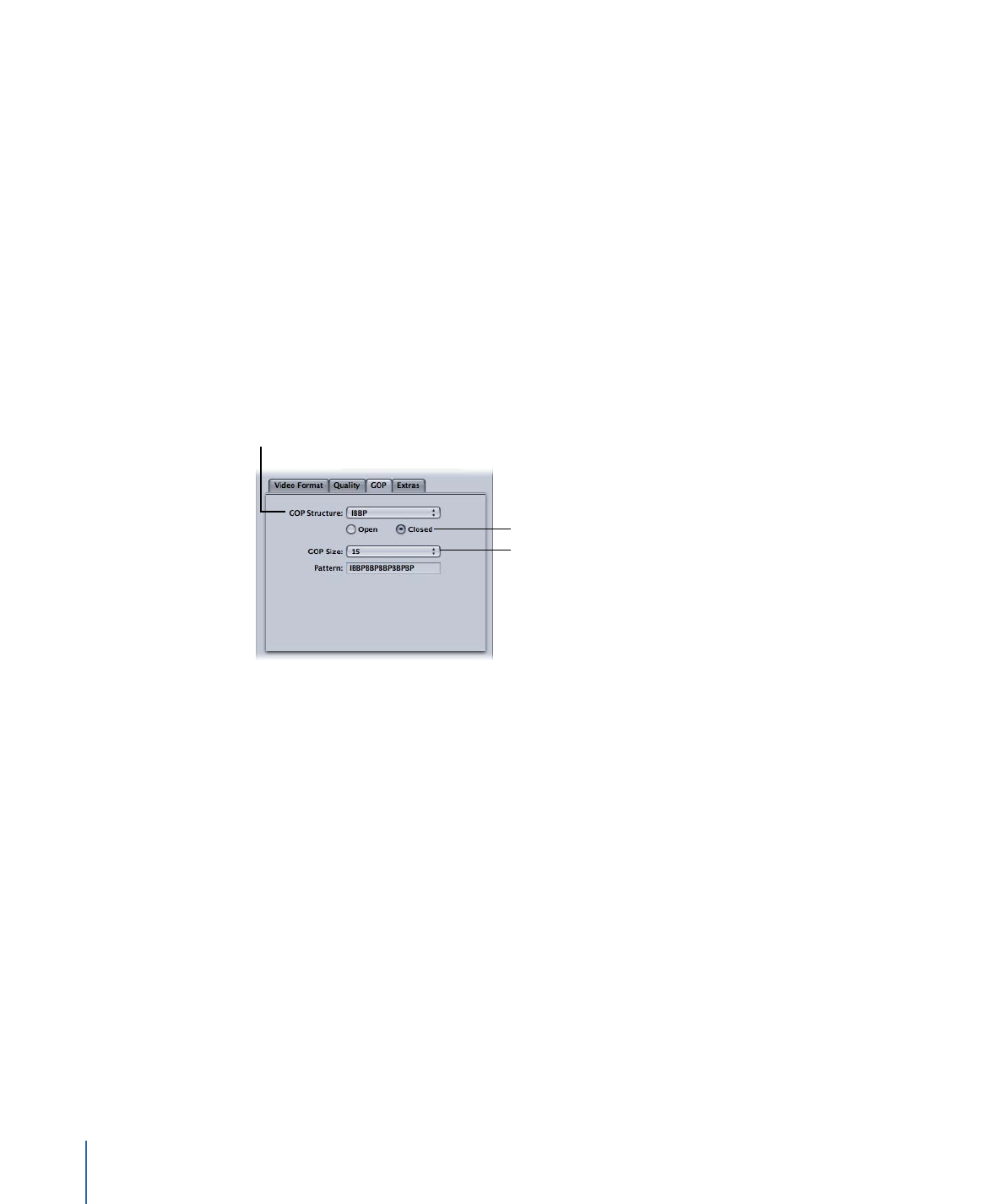
Choosing Quality Settings
In the Quality tab, you set the MPEG-2 encoding attributes that have the greatest influence
on the resulting quality of your MPEG-2 video output file: encoding mode, average and
maximum bit rate, and type of motion estimation.
To open the Quality tab and choose the Quality settings
1
Click the Quality button in the MPEG-2 Encoder pane to open the Quality tab.
Choose a Motion
Estimation setting.
Choose a mode that
fits your time and
quality requirements.
Choose bit rates that
fit your file size and
quality requirements.
2
Make a selection from the Mode pop-up menu.
For best image quality, choose “One pass VBR Best” or “Two pass VBR Best.” For faster
encoding, with excellent image quality, choose “One pass VBR” or “Two pass VBR.” For
HD sources, choose either “One pass VBR Best” or “Two pass VBR Best.”
With two-pass modes, the source media file is examined on the first pass and transcoded
on the second pass, with bit rates tailored to the video content. Alternatively, one-pass
modes transcode the material more quickly, but allocate bits less optimally than do the
corresponding two-pass modes.
Note: If you are using two-pass VBR with distributed processing enabled, you may want
to deselect the Allow Job Segmenting checkbox in the Encoder pane. See
Job Segmenting
and Two-Pass or Multi-Pass Encoding
for more information.
212
Chapter 18
Creating MPEG-2 Output Files

3
Choose an average bit rate using the Average Bit Rate slider or field or click the Automatic
button.
Choose an appropriate bit rate based on the content and length of your source video
and the intended size (in bytes) of your output file. In DVD authoring, the entire video
must fit on the DVD disc—the lower the bit rate, the more data you can store. However,
the higher the bit rate, the better the image quality will be.
As you change the Average Bit Rate value (with the slider or the field), the bit-rate
calculator at the bottom of the Quality tab dynamically shows the maximum number of
minutes of video on a DVD-5. The calculator assumes 1.5 Mbps for audio (two-channel
AIFF).
See the table below for some average bit rates and corresponding footage times for a
4.7 GB DVD.
4
If available, use the Maximum Bit Rate slider or field to set a maximum bit rate.
Because SD DVD players support peak bit rates of up to 10.08 Mbps for video plus audio,
you should set the maximum video bit rate between 8.0 and 8.5 Mbps if you are using a
1.5 Mbps (two-channel AIFF) audio track.
Note: For best results, make sure the maximum bit rate is at least 1 Mbps higher than
the average setting. Larger differences can produce better results.
5
Choose one of the following settings from the Motion Estimation pop-up menu:
• Good: The fastest motion estimation setting—sufficient when there is relatively low
motion between frames
• Better: A good general-purpose motion estimation setting—provides very good results
even in the presence of complex interlaced motion
• Best: The highest quality setting to handle the most demanding and complex motion
for interlaced sources—somewhat slower than the Better mode
See
Quality Tab
for more information.
The following table shows some average bit rates and corresponding footage times for
a 4.7 GB DVD:
Approximate duration for 4.7 GB DVD
Average bit rate
1
121 minutes
3.5 Mbps
94 minutes
5.0 Mbps
82 minutes
6.0 Mbps
68 minutes
7.5 Mbps
65 minutes
8.0 Mbps
1 For a DVD clip with video, audio, and subpictures: assumes 1.5 Mbps for audio (two-channel AIFF).
213
Chapter 18
Creating MPEG-2 Output Files

Note: When “One pass VBR or “One pass VBR Best” is chosen for very short clips (less than
a minute or two in length), the resulting MPEG-2 output file size may not accurately reflect
the average bit rate you specified. If the MPEG-2 output media file is larger than you want,
you can try transcoding it again at a lower average bit rate.
Stage 3: